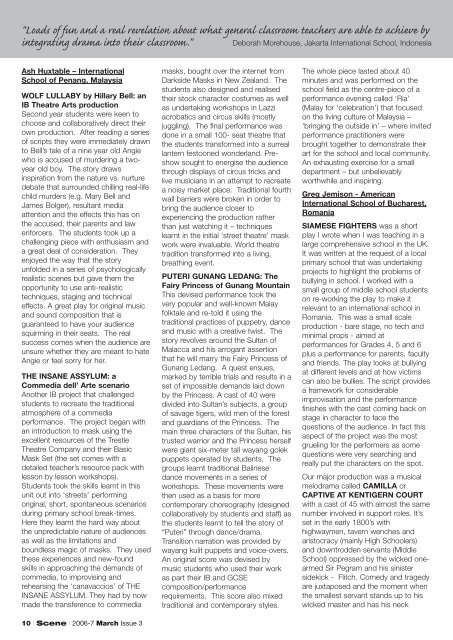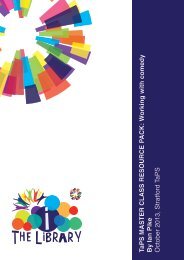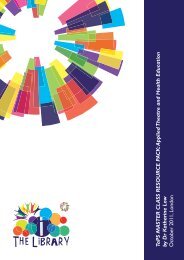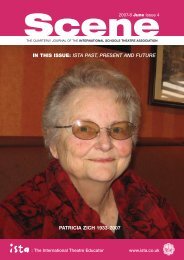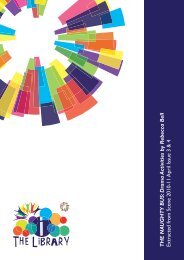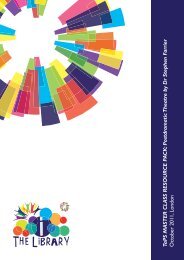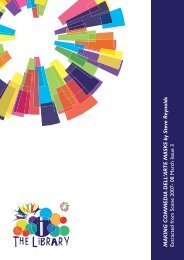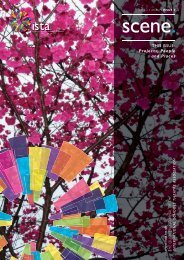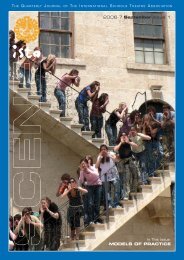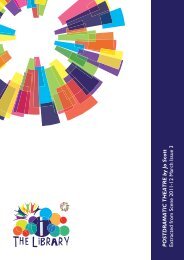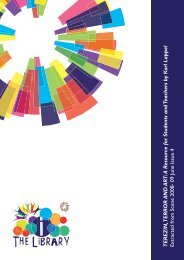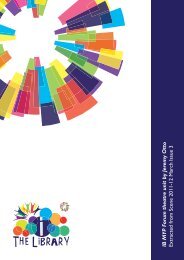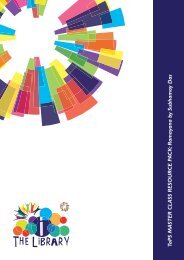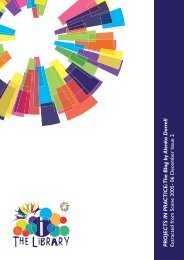ISTA/Scene March 07
ISTA/Scene March 07
ISTA/Scene March 07
You also want an ePaper? Increase the reach of your titles
YUMPU automatically turns print PDFs into web optimized ePapers that Google loves.
“Loads of fun and a real revelation about what general classroom teachers are able to achieve by<br />
integrating drama into their classroom.”<br />
Deborah Morehouse, Jakarta International School, Indonesia<br />
Ash Huxtable – International<br />
School of Penang, Malaysia<br />
WOLF LULLABY by Hillary Bell: an<br />
IB Theatre Arts production<br />
Second year students were keen to<br />
choose and collaboratively direct their<br />
own production. After reading a series<br />
of scripts they were immediately drawn<br />
to Bell’s tale of a nine year old Angie<br />
who is accused of murdering a twoyear<br />
old boy. The story draws<br />
inspiration from the nature vs. nurture<br />
debate that surrounded chilling real-life<br />
child murders (e.g. Mary Bell and<br />
James Bolger), resultant media<br />
attention and the effects this has on<br />
the accused, their parents and law<br />
enforcers. The students took up a<br />
challenging piece with enthusiasm and<br />
a great deal of consideration. They<br />
enjoyed the way that the story<br />
unfolded in a series of psychologically<br />
realistic scenes but gave them the<br />
opportunity to use anti-realistic<br />
techniques, staging and technical<br />
effects. A great play for original music<br />
and sound composition that is<br />
guaranteed to have your audience<br />
squirming in their seats. The real<br />
success comes when the audience are<br />
unsure whether they are meant to hate<br />
Angie or feel sorry for her.<br />
THE INSANE ASSYLUM: a<br />
Commedia dell’ Arte scenario<br />
Another IB project that challenged<br />
students to recreate the traditional<br />
atmosphere of a commedia<br />
performance. The project began with<br />
an introduction to mask using the<br />
excellent resources of the Trestle<br />
Theatre Company and their Basic<br />
Mask Set (the set comes with a<br />
detailed teacher’s resource pack with<br />
lesson by lesson workshops).<br />
Students took the skills learnt in this<br />
unit out into ‘streets’ performing<br />
original, short, spontaneous scenarios<br />
during primary school break-times.<br />
Here they learnt the hard way about<br />
the unpredictable nature of audiences<br />
as well as the limitations and<br />
boundless magic of masks. They used<br />
these experiences and new-found<br />
skills in approaching the demands of<br />
commedia, to improvising and<br />
rehearsing the ‘canavaccios’ of THE<br />
INSANE ASSYLUM. They had by now<br />
made the transference to commedia<br />
10 | <strong>Scene</strong> | 2006-7 <strong>March</strong> Issue 3<br />
masks, bought over the internet from<br />
Darkside Masks in New Zealand. The<br />
students also designed and realised<br />
their stock character costumes as well<br />
as undertaking workshops in Lazzi<br />
acrobatics and circus skills (mostly<br />
juggling). The final performance was<br />
done in a small 100- seat theatre that<br />
the students transformed into a surreal<br />
lantern festooned wonderland. Preshow<br />
sought to energise the audience<br />
through displays of circus tricks and<br />
live musicians in an attempt to recreate<br />
a noisy market place. Traditional fourth<br />
wall barriers were broken in order to<br />
bring the audience closer to<br />
experiencing the production rather<br />
than just watching it – techniques<br />
learnt in the initial ‘street theatre’ mask<br />
work were invaluable. World theatre<br />
tradition transformed into a living,<br />
breathing event.<br />
PUTERI GUNANG LEDANG: The<br />
Fairy Princess of Gunang Mountain<br />
This devised performance took the<br />
very popular and well-known Malay<br />
folktale and re-told it using the<br />
traditional practices of puppetry, dance<br />
and music with a creative twist. The<br />
story revolves around the Sultan of<br />
Malacca and his arrogant assertion<br />
that he will marry the Fairy Princess of<br />
Gunang Ledang. A quest ensues,<br />
marked by terrible trials and results in a<br />
set of impossible demands laid down<br />
by the Princess. A cast of 40 were<br />
divided into Sultan’s subjects, a group<br />
of savage tigers, wild men of the forest<br />
and guardians of the Princess. The<br />
main three characters of the Sultan, his<br />
trusted warrior and the Princess herself<br />
were giant six-meter tall wayang golek<br />
puppets operated by students. The<br />
groups learnt traditional Balinese<br />
dance movements in a series of<br />
workshops. These movements were<br />
then used as a basis for more<br />
contemporary choreography (designed<br />
collaboratively by students and staff) as<br />
the students learnt to tell the story of<br />
“Puteri” through dance/drama.<br />
Transition narration was provided by<br />
wayang kulit puppets and voice-overs.<br />
An original score was devised by<br />
music students who used their work<br />
as part their IB and GCSE<br />
composition/performance<br />
requirements. This score also mixed<br />
traditional and contemporary styles.<br />
The whole piece lasted about 40<br />
minutes and was performed on the<br />
school field as the centre-piece of a<br />
performance evening called ‘Ria’<br />
(Malay for ‘celebration’) that focused<br />
on the living culture of Malaysia –<br />
‘bringing the outside in’ – where invited<br />
performance practitioners were<br />
brought together to demonstrate their<br />
art for the school and local community.<br />
An exhausting exercise for a small<br />
department – but unbelievably<br />
worthwhile and inspiring.<br />
Greg Jemison - American<br />
International School of Bucharest,<br />
Romania<br />
SIAMESE FIGHTERS was a short<br />
play I wrote when I was teaching in a<br />
large comprehensive school in the UK.<br />
It was written at the request of a local<br />
primary school that was undertaking<br />
projects to highlight the problems of<br />
bullying in school. I worked with a<br />
small group of middle school students<br />
on re-working the play to make it<br />
relevant to an international school in<br />
Romania. This was a small scale<br />
production - bare stage, no tech and<br />
minimal props - aimed at<br />
performances for Grades 4, 5 and 6<br />
plus a performance for parents, faculty<br />
and friends. The play looks at bullying<br />
at different levels and at how victims<br />
can also be bullies. The script provides<br />
a framework for considerable<br />
improvisation and the performance<br />
finishes with the cast coming back on<br />
stage in character to face the<br />
questions of the audience. In fact this<br />
aspect of the project was the most<br />
grueling for the performers as some<br />
questions were very searching and<br />
really put the characters on the spot.<br />
Our major production was a musical<br />
melodrama called CAMILLA or<br />
CAPTIVE AT KENTIGERN COURT<br />
with a cast of 45 with almost the same<br />
number involved in support roles. It’s<br />
set in the early 1800’s with<br />
highwaymen, tavern wenches and<br />
aristocracy (mainly High Schoolers)<br />
and downtrodden servants (Middle<br />
School) oppressed by the wicked onearmed<br />
Sir Pegram and his sinister<br />
sidekick - Flitch. Comedy and tragedy<br />
are juxtaposed and the moment when<br />
the smallest servant stands up to his<br />
wicked master and has his neck


